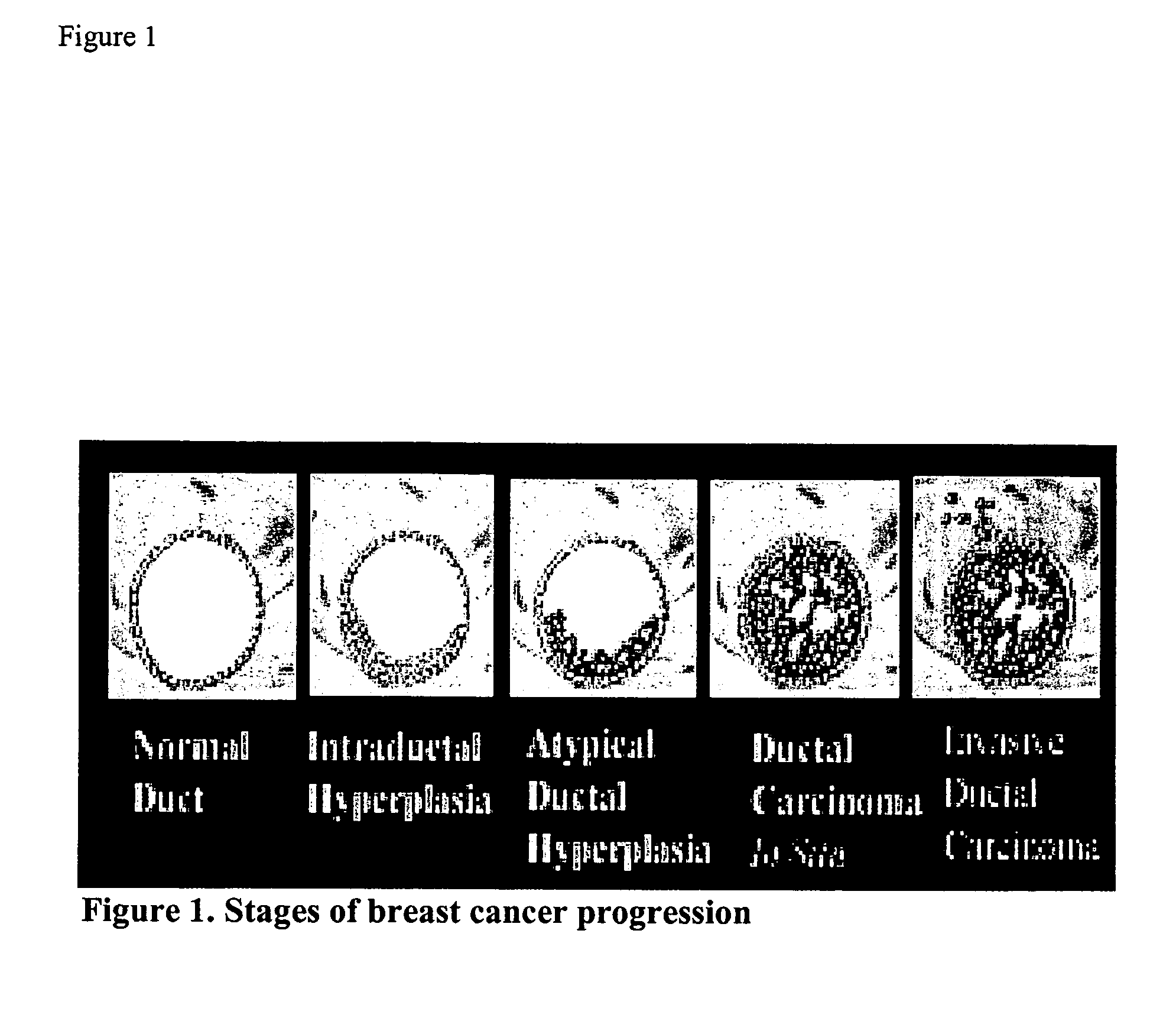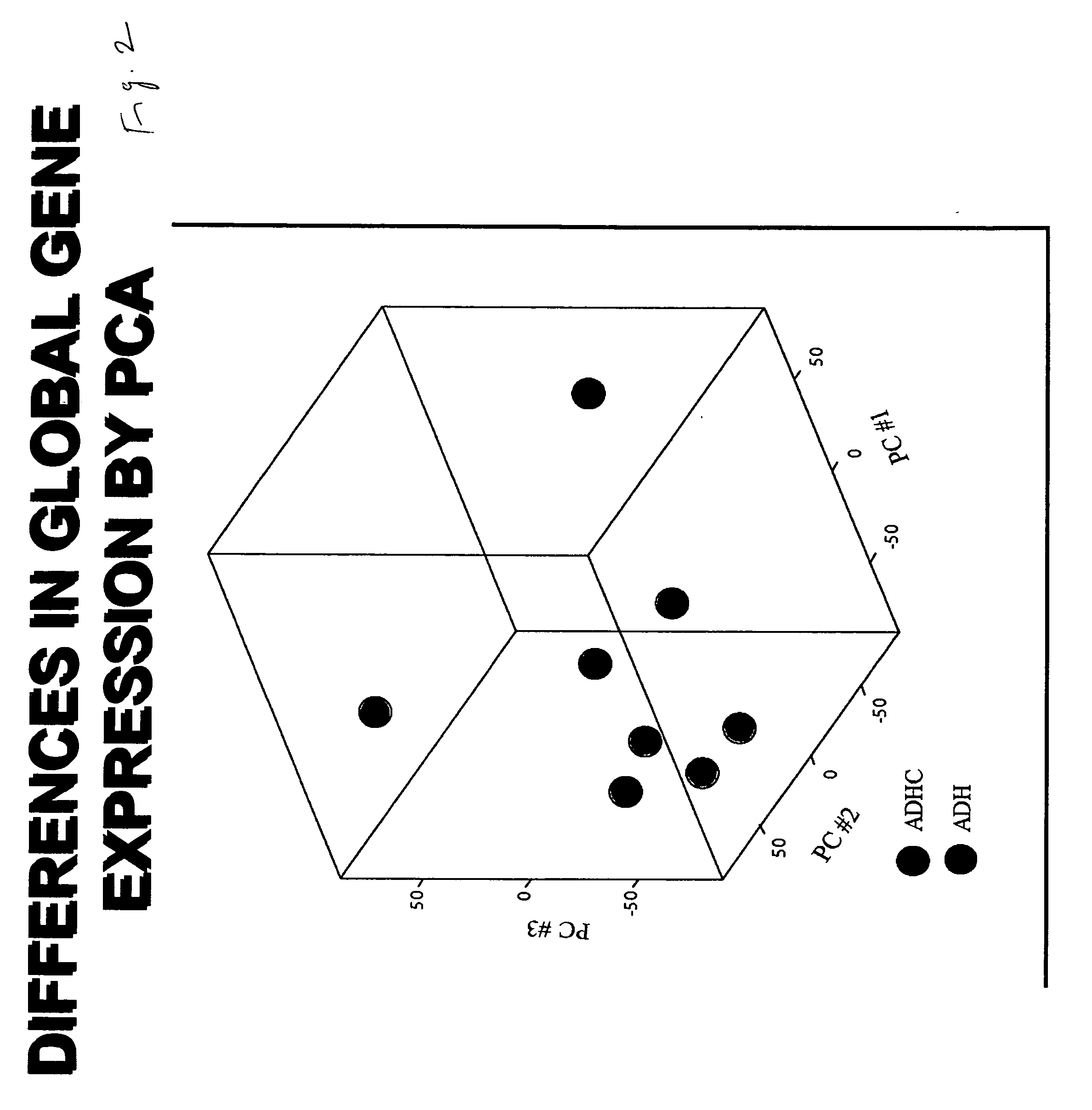Molecular Markers that predict breast cancer development
a technology of molecular markers and breast cancer, applied in the field of isolated genes, can solve the problems of atypical cells not necessarily, mortality rate has slightly declined, and remains very high, and achieve the effect of preventing a hyperprolific condition
- Summary
- Abstract
- Description
- Claims
- Application Information
AI Technical Summary
Benefits of technology
Problems solved by technology
Method used
Image
Examples
example 1
[0081] This example shows that gene expression in ADHC is significantly different from ADH tissues and several genes are altered significantly in ADHC tissues. To identify the differentially altered genes, first, the gene expression profiles of ADH and ADHC were analyzed by unsupervised Principal Component Analysis (PCA) using signals of all the expressed genes (Table 2) and after removing absent calls and genes with 50% missing data.
TABLE 2Summary of number of genes called present in the samples analyzedby Affymetrix Microarray Suite (MAS) ver. 5 SoftwareSampleNumber of genesPercent Present andNamepresent and MarginalMarginally PresentADH111,53952%ADH212,11654%ADH312,82958%ADH412,51156%ADHC112,05654%ADHC210,84949%ADHC311,89753%ADHC412,18454%
[0082] A projection on three principal components accounting for 62% of the variance revealed clear segregation between ADH and ADHC arrays as shown in FIG. 2, indicating that the global gene expression patterns of these two groups are signifi...
example 2
[0087] This example shows how micro-array data is verified by Taqman quantitative real-time PCR. To verify micro-array data, the expression of a set of 5 genes, MMP-1, CEACAM5, BCL2A, ER∃, and HEC were examined in a total of ten ADH, and six ADHC samples by reverse transcription quantitative real-time PCR. These genes were chosen because of their functional significance and their expression in breast cancer tissues have been well established (Lacroix, M. et al The International J. Biological Markers. 17, 5-23 (2002)). With an exception of ER∃, the expressions of all other four genes were significantly elevated in ADHC samples by micro-array analysis. Profiling their expression by quantitative real-time PCR showed excellent concordance with the micro-array data (FIG. 6). Quantitative real-time PCR validation clearly established the authenticity of micro-array data obtained by global gene expression analysis on Affymatrix platform.
example 3
[0088] This example shows that the genes that were differentially altered in ADHC tissues regulate several cellular processes (Poola et al, Nature Medicine, 11, 481-483, 2005). Based on the differentially expressed genes in ADHC, some of the cellular processes that are altered in ADHC tissues are shown in Table 3 and described below. Briefly, the ADHC tissues have:
TABLE 3Cellular processes deregulated in ADHC tissuesGenes SignificantlyCellular ProcessGenes Significantly Up-RegulatedDown-RegulatedCell Cycle CheckCyclin A, Cyclin E, Cyclin B, CDC2,NonePointsNEK2, HCAPG, CENPA, CENPF,MAD2L1, BUB1, PTTG1, CDC20, ANKT,HEC, KIF2C, RAMP, PRC1, DOCK2,KIF20ANucleic AcidTK1, RRM2, and Thymidylate SynthaseAK5BiosynthesisEstrogen MetabolismHSD17B1UGT2B23Cell-Cell and Cell-MMP-1, MMP-3, MMP-9, MMP-11, MMP-SERPINA-3, and -5ECM Interactions12, MMP-13, MMP-19, PLAUR (Urokinasereceptor) and Cathepsin CCell Surface PolarityCEACAM5, CEACAM6, Galectin 5,CELSR-1, and -2,and ArchitectureGalectin-9, CDH...
PUM
| Property | Measurement | Unit |
|---|---|---|
| 2D gel electrophoresis | aaaaa | aaaaa |
| Spectroscopy | aaaaa | aaaaa |
| morphology | aaaaa | aaaaa |
Abstract
Description
Claims
Application Information
 Login to View More
Login to View More - R&D
- Intellectual Property
- Life Sciences
- Materials
- Tech Scout
- Unparalleled Data Quality
- Higher Quality Content
- 60% Fewer Hallucinations
Browse by: Latest US Patents, China's latest patents, Technical Efficacy Thesaurus, Application Domain, Technology Topic, Popular Technical Reports.
© 2025 PatSnap. All rights reserved.Legal|Privacy policy|Modern Slavery Act Transparency Statement|Sitemap|About US| Contact US: help@patsnap.com



